Last updated: January 11, 2021
Article
Elephant Seal Monitoring Season Summary: Winter 2019-2020
Season Overview
- Elephant seal population numbers are similar to last year.
- Biologists missed no weekly surveys due to weather, however haze and fog affected visibility at some sites.
- A mild winter contributed to low pup mortality with about 1,000 pups surviving to weaning.
- Deterrence methods to move pregnant females from the beach in front of Ken Patrick Visitor Center appeared successful, with the majority of hazed females re-sighted with pups farther south on Drakes Beach.
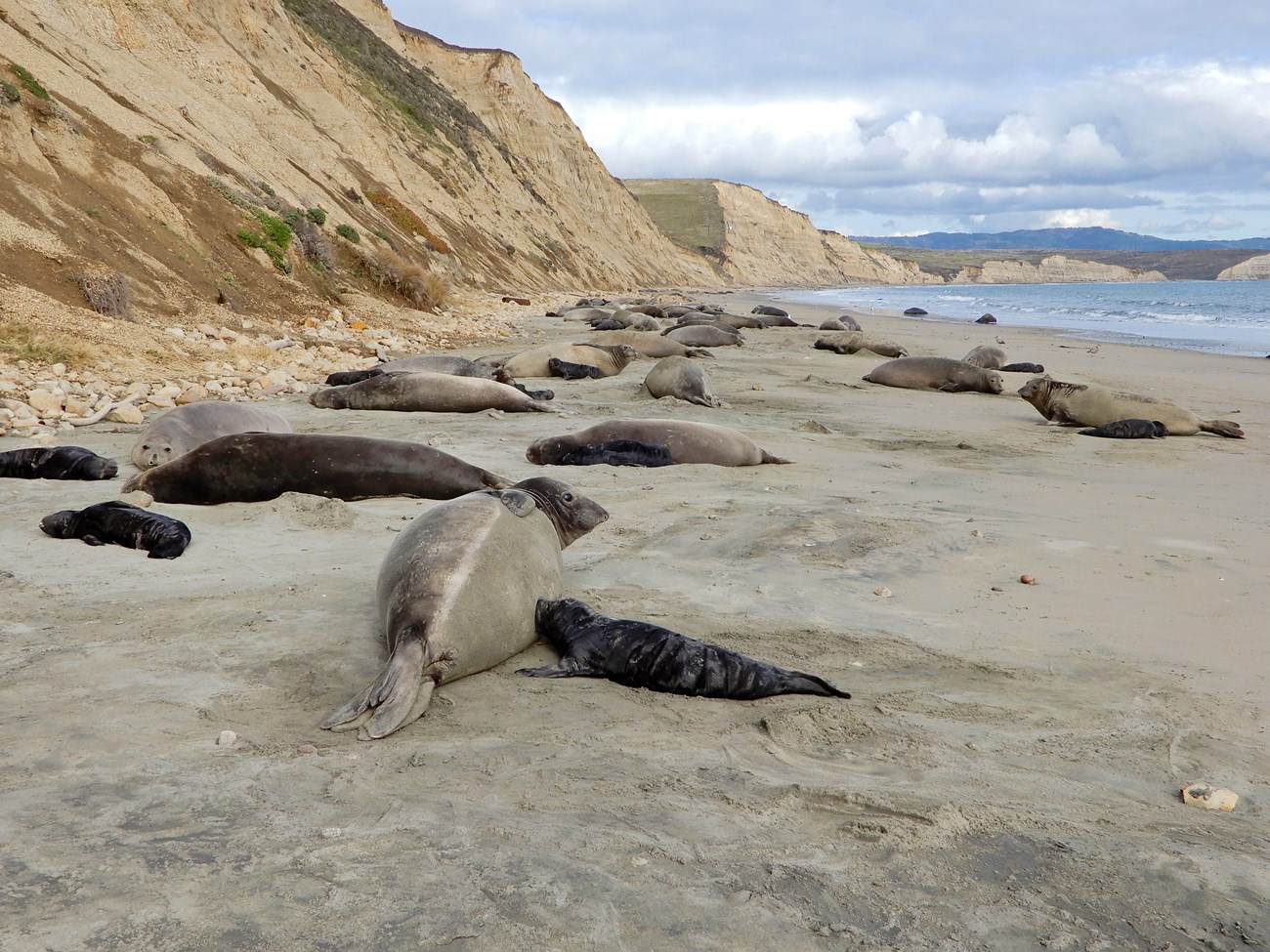
NPS / Marjorie Cox, NMFS Permit No. 21425
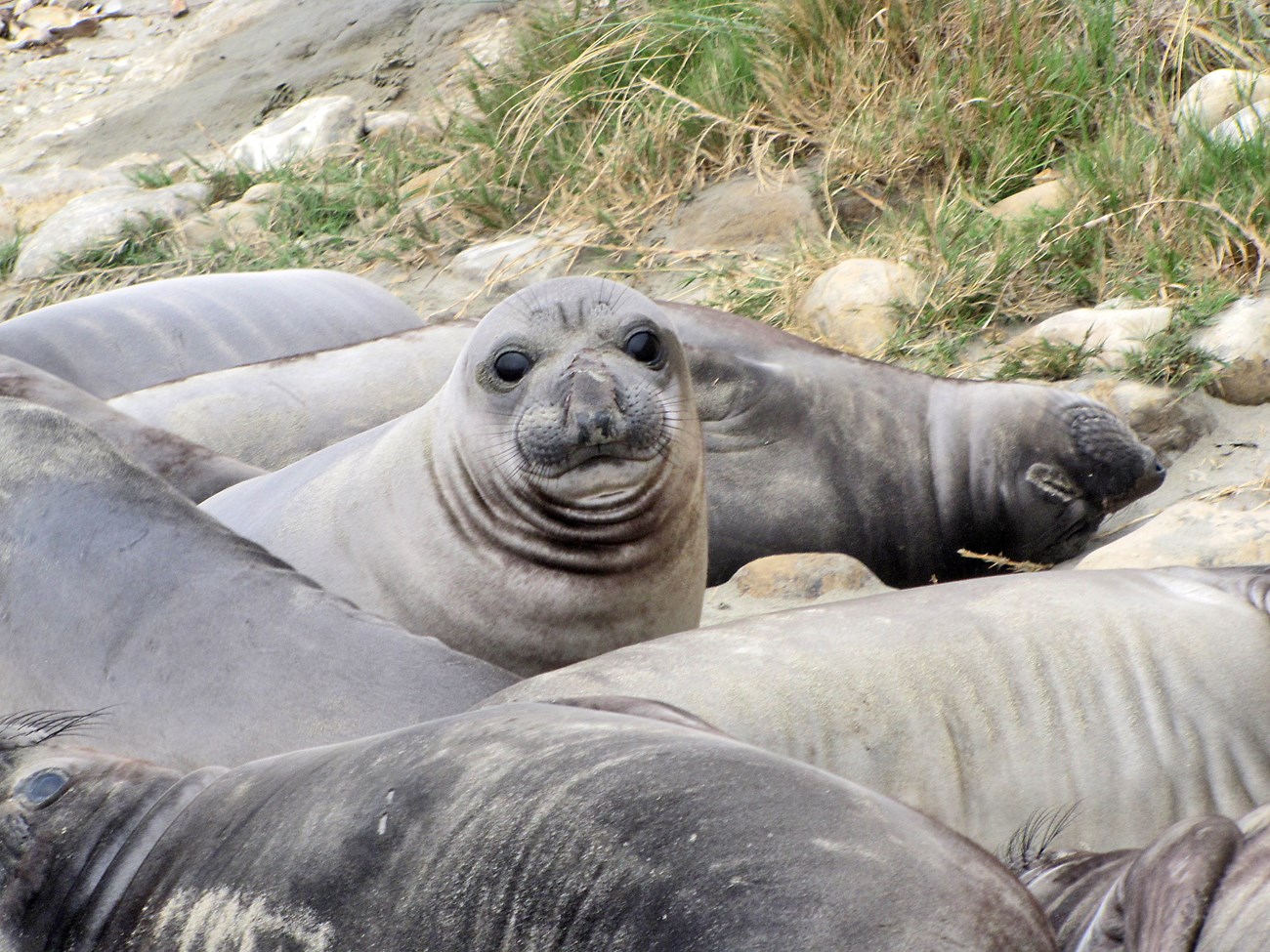
NPS / Marjorie Cox NMFS Permit No. 21425
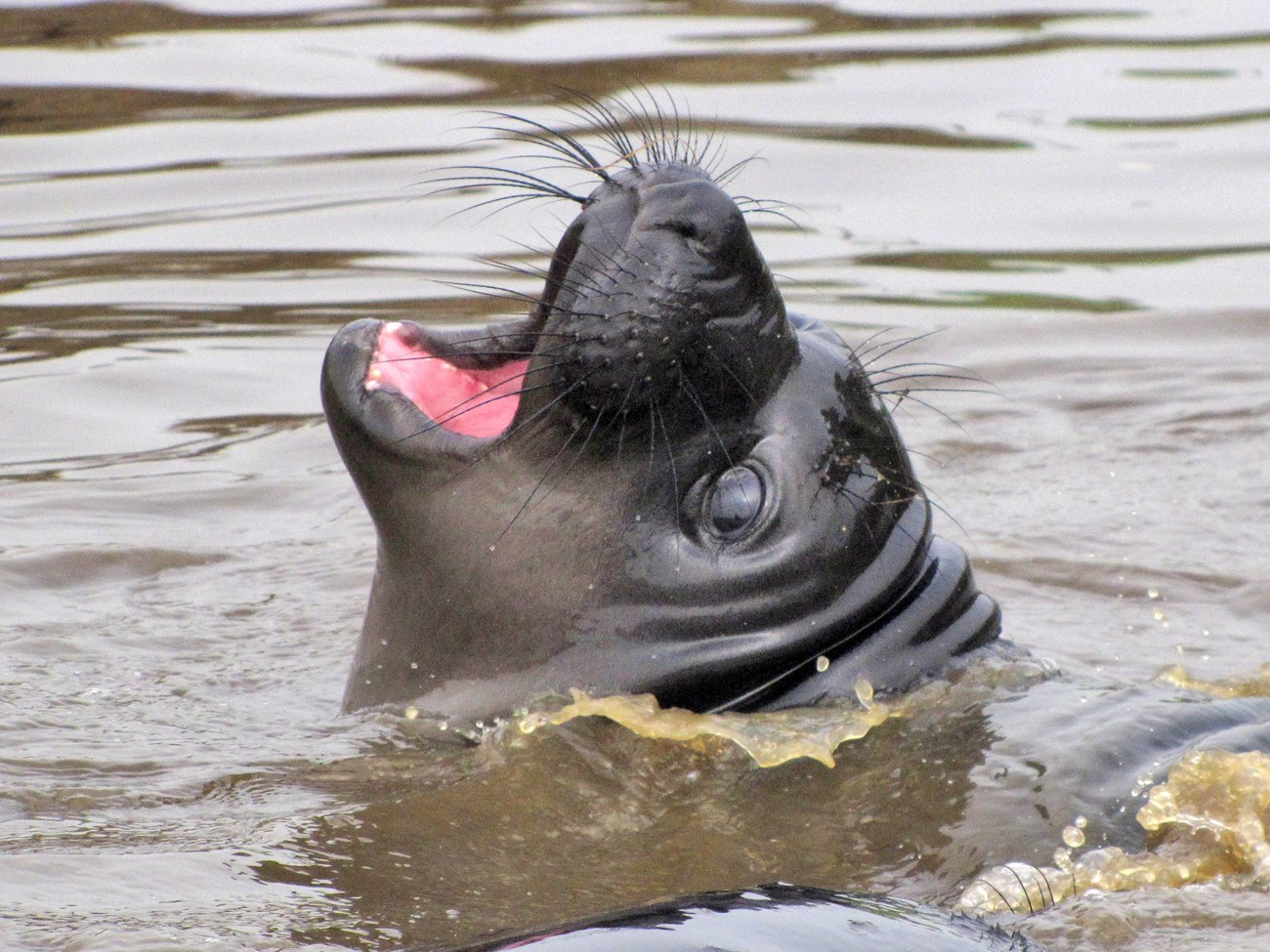
NPS / Marjorie Cox, NMFS Permit No. 21425
Tag-stravaganza!
| Year | Number Tagged |
|---|---|
| 2016 | 369 |
| 2017 | 361 |
| 2018 | 415 |
| 2019 | 492 |
| 2020 | 536 |
Researchers at Point Reyes have been successful in increasing the number of seal taggings over the past three years. Tagging opportunities are tide and weather dependent, but another factor in this success is the dynamic movement of the seals within the park. Over the past several years the number of pups born on Drakes Beach has increased dramatically. Unlike some of the ocean facing colonies under steep cliffs, Drakes Beach is accessible to researchers. More accessible pups mean more accessible hind flippers, and more accessible hind flippers means more tags deployed!

NPS / Marjorie Cox, NMFS Permit No. 21425
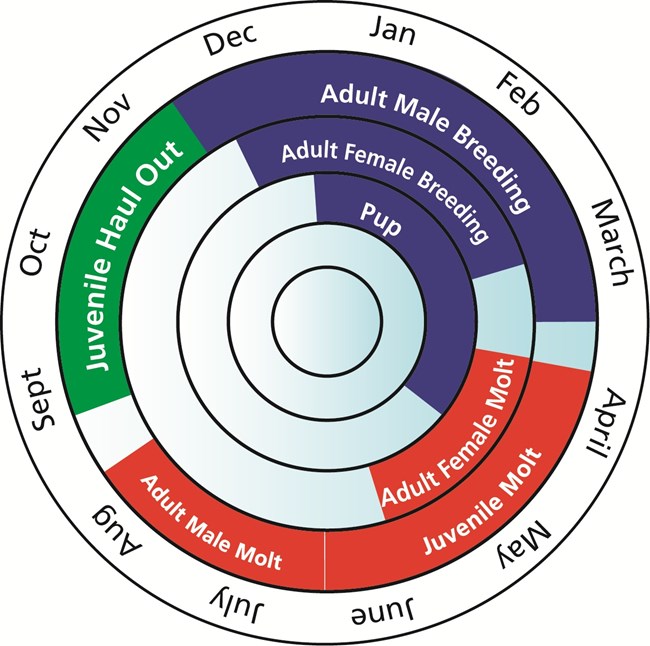
Seasons of the Seal
Point Reyes beaches are full of weaned elephant seal pups. As the seals get older and bolder it is more common to see them paddling around in shallow water close to shore. Adult females here for pupping and breeding have all departed, but a few newly arrived adult females that are here to molt have been spotted in the park. While the majority of molting females arrive in April, it is not uncommon for a few early arrivals to show up in March. During the molt season, seals are often in very close contact with other seals, much closer than a female with a pup would tolerate! The body contact, and the heat it generates, is a benefit to the molting process.
By the Numbers
Elephant Seal Seasonal Peak Numbers Mostly Rising
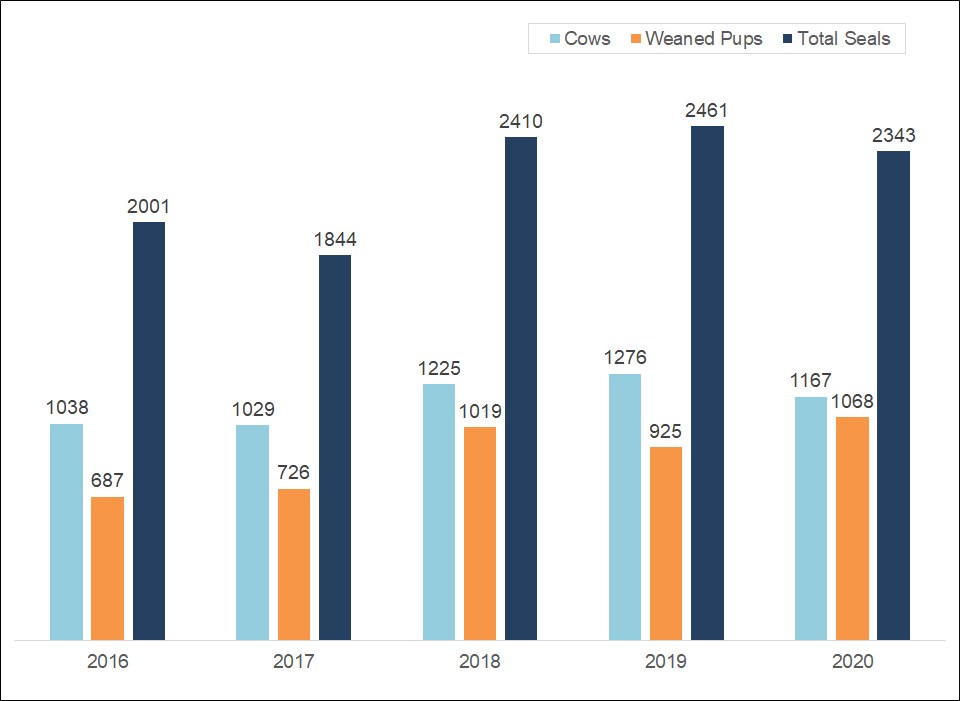
Total Elephant Seal Counts, Winter 2019-2020
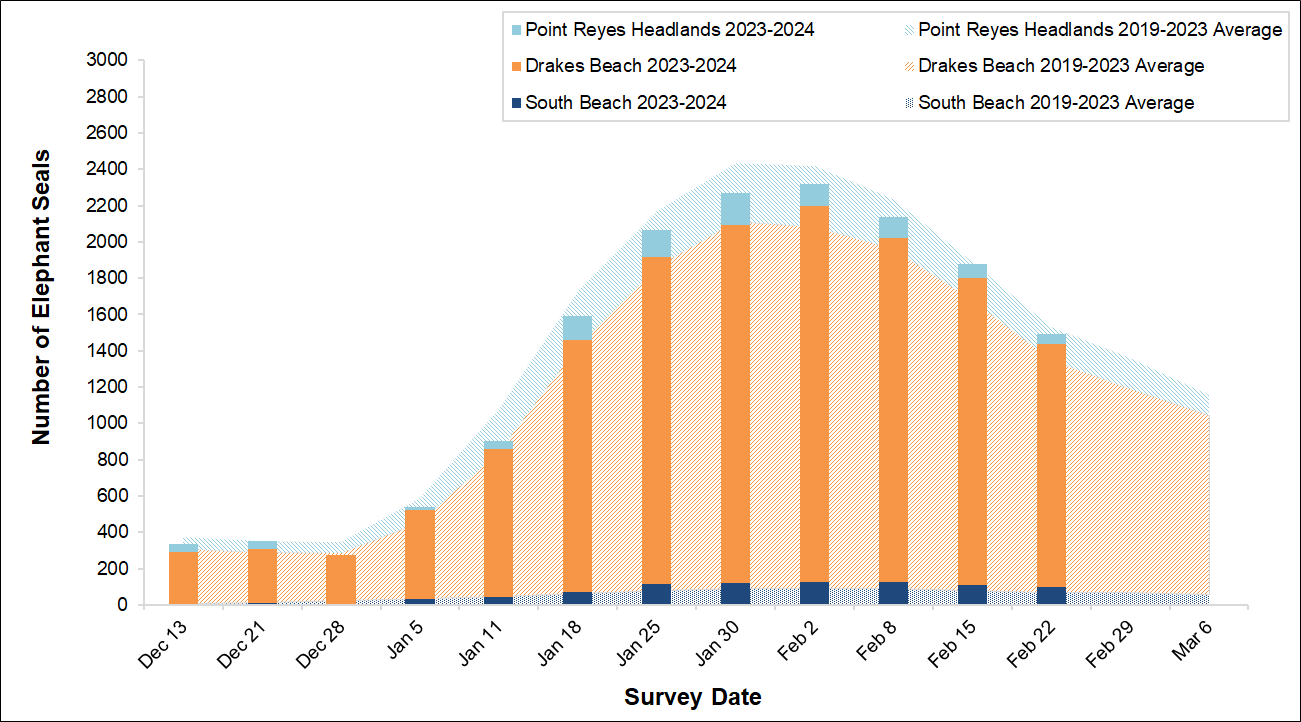
Female Elephant Seal Counts, Winter 2023-2024
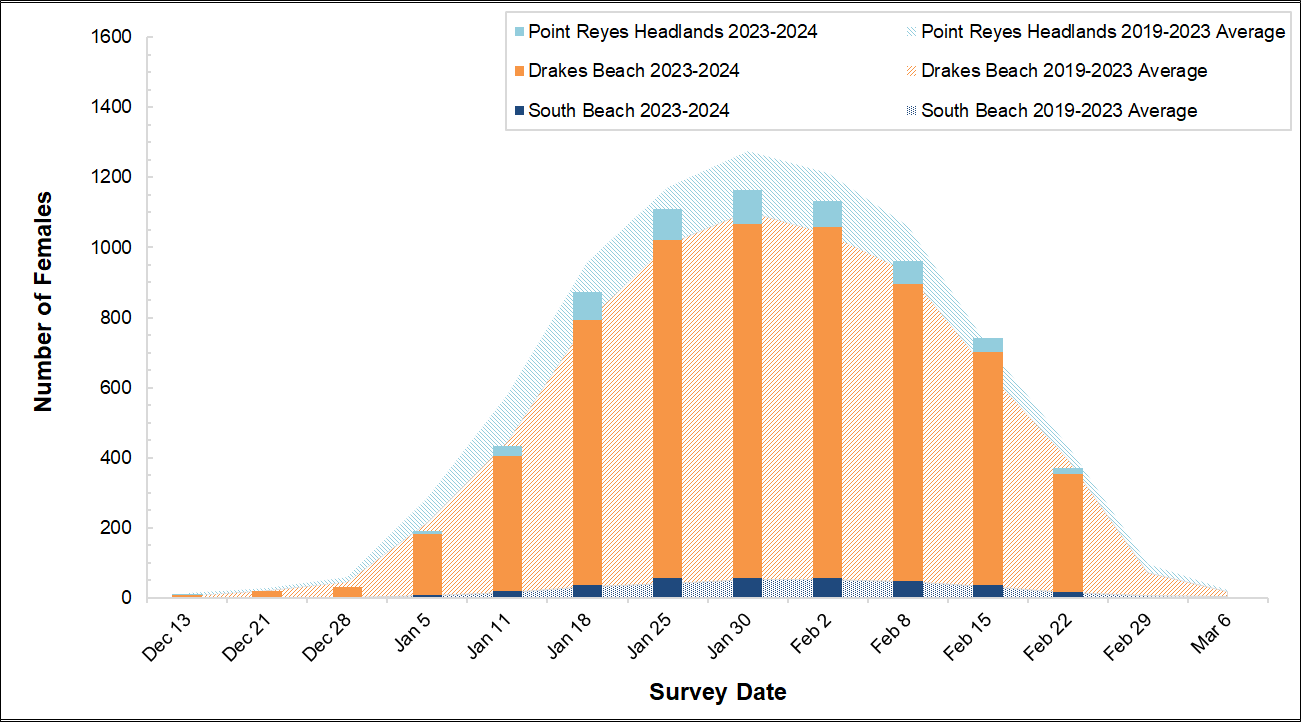
Elephant Seal Pup Counts, Winter 2023-2024
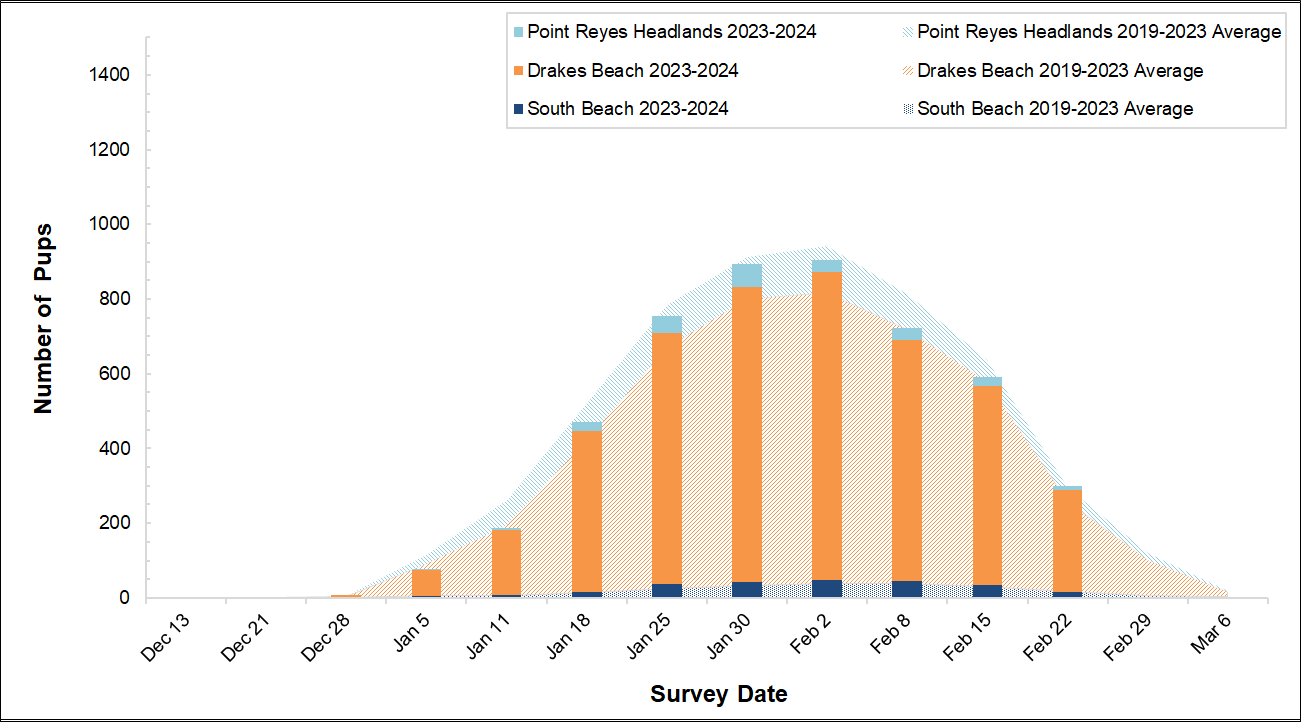
Elephant Seal Weaned Pup Counts, Winter 2023-2024
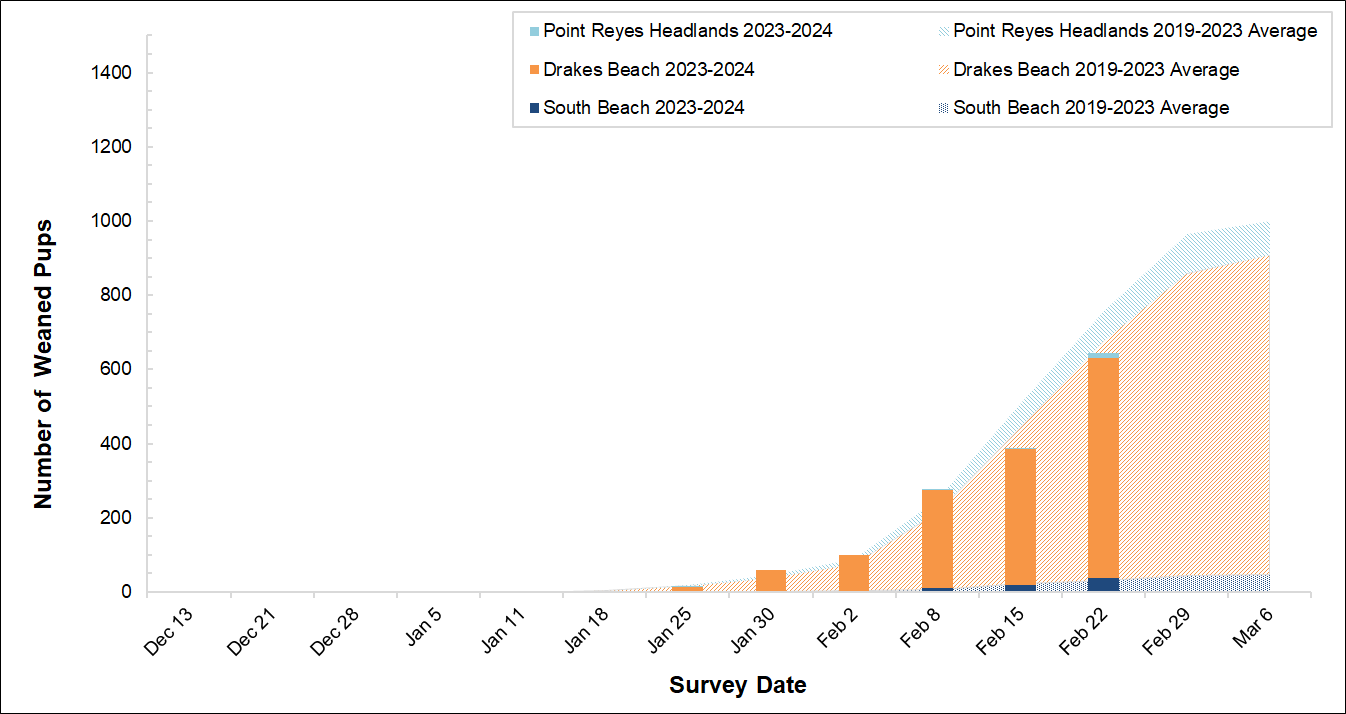
Weelky Updates Recap
News This Week
- The first pups of the season have arrived!
- Many immature elephant seals remain on beaches, but the majority will be departing soon.
- Researchers dye marked bulls to track their movement around the park.
- Closures are in effect at the Fish Dock, Lifeboat Station, and the south end of South Beach.
- Drakes Beach south of the visitor center is also closed. The closure begins at the cliff edge to the right of the visitor center parking lot.
Adult Male Weight: 4,400-6,000 lbs.
Adult Female Weight: 1,300-1,900 lbs.
Pup Weight: 60-75 lbs.
Weaned Pup Weight: approx. 300 lbs.
Adult Male Length: 12-18 ft.
Adult Female Length: 9-10 ft.
Pup Length: 3.2-4 ft
Nursing Duration: approx. 28 days
Male Lifespan: 12-14 years
Female Lifespan: 16-18 years
Yearly Migration Distance (M): 13,000 miles
Yearly Migration Distance (F): 12,000 miles
Dive Depth: avg. 1,000 ft.
Deepest Recorded Dive: 5,788 ft. (adult female)
Dominance Decides
Visitors and park staff have been lucky to witness some epic battles between adult male elephant seals this winter on Drakes Beach, one reported to have lasted about 20 minutes! It is extremely rare to witness a prolonged fight. A study out of Santa Cruz found that 2/3 of observed fights lasted less than 30 seconds. Some pinnipeds, like sea lions, establish a set territory of a few meters to defend. Elephant seals are not territorial, their aggressive behavior is all about asserting dominance over rival males and guarding a group of females. Although rarely fatal, aggressive encounters are extremely energetically taxing, and through vocalizations and body posturing a dominant male will attempt to deter a physical interaction.
- Pregnant female elephant seal arrivals and pup births see a steep increase from the previous week.
- Researchers conclude dye marking adult males.
- The beach in front of Ken Patrick Visitor Center remains open. Drakes Beach south of the visitor center is closed. The closure begins at the cliff edge to the right of the visitor center parking lot.
Researchers in the park have dye marked over 40 adult males so far this year. Using black human hair dye, the seals are marked with a letter code denoting location (ex: D= Drakes Beach, G= Gus’ Cove, V=Visitor Center) and numbered for each location consecutively (ex: D1 is the first male marked on Drakes Beach). Seal G1 is a known age tagged seal, with pink flipper tag M433. The dye mark will allow us to track his movements around the colony over the season, and the flipper tag gives us an idea of his life history within the park. M433 was tagged as a weaned pup in February of 2009 on Drakes Beach. His tag was not re-sighted again until January of 2015, where he was seen twice at Drakes Beach and Gus’ Cove (a cove near Chimney Rock). M433 has been sighted every breeding season since, in and around the Drakes Beach area. In 2018, as a sub-adult, he was first recorded as a peripheral male, meaning he was close to a group of females and may have attempted to mate. In February of 2019 he was recorded as alpha male in a cove near Chimney Rock, where he was re-sighted as alpha twice more that season. This 10 year old bull has been dye marked this year at Gus’ Cove, and was re-sighted on Jan. 9 at the beach below the Elephant Seal Overlook in alpha position!
The Tide Is HighThe second weekend of January brings with it king tides of over 6 ½ feet. Extremely high tides can be detrimental to pup survival, as pups are not able to swim. Luckily this weekend no large storms or swells are forecast. When these combine with king tides it can wash out entire beaches. During king tides, if the seas are calm, pups may get wet, but are able to avoid being washed out to sea. On Friday researchers checked on several sites during the king tide, and our most vulnerable beaches appeared to have plenty of space for the seals. Big storms combined with very high tides were likely a contributor to the seal “take over” at Ken Patrick Visitor Center last January, when seals moved into the more protected bay from the headlands.
- Pregnant female elephant seal arrivals and pup births continue to increase.
- Yearling and immature seals have departed the park in large numbers.
- The beach in front of Ken Patrick Visitor Center remains open. Drakes Beach south of the visitor center is closed. The closure begins at the cliff edge to the right of the visitor center parking lot.
As the peak of the breeding season approaches, pup births are happening frequently throughout the park. To witness a birth is a matter of right place/right time luck. However, there are some key signs of an impending birth to look out for. An adult female that is pregnant will have a very round body shape, and sometimes you can even see a “pup lump” protruding from her side. When females are approaching labor they often have a glazed look in their eyes, may appear agitated or restless, and may vocalize to other pups around them. Typically females will have visible contractions from her mid to posterior body, and then she will begin arching her back and lifting her flippers. Once you observe her water breaking, then it is likely a birth is imminent. As her hind-flippers lift and she starts to strain, you may be able to see the hind-flippers or head appearing. Elephant seals give birth about 50-50 head first (cephalic) versus hind-flippers first (caudal). Like humans, the time it takes from the start of labor to birth varies between seals. It can happen while you look away for a moment or take over an hour. Count yourself as a lucky seal observer if you get to witness mom’s first warbles to her brand new pup!
The Snout With The CloutMale elephant seals have what is known as secondary sexual traits, physical traits that are not directly concerned with reproduction. In elephant seals, the secondary sexual traits are more about asserting dominance over other males than attracting a female mate. The trait they are probably most famous for is their large fleshy proboscis. But what is the function of this magnificent appendage? There is a correlation between body size and proboscis size in elephant seals, and large seals tend to have greater stamina and power in aggressive interactions (although there are exceptions). In most aggressive displays, males face each other and, therefore, the actual size of the appendage is not readily apparent to the opposing male. Perhaps the size of the appendage is not a visual tool of intimidation, but an auditory one due to the sound it helps produce. The threat clap of the elephant seal is produced in the vocal chords, but it appears that the inflated chambers of the proboscis act as an extension of the vocal chords, amplifying the vocal display. What an elaborate way to say, “You don’t want to mess with me dude!”.
- The season's first weaned elephant seal pups have been sighted.
- Pregnant female arrivals and pup births continue to increase.
- The beach in front of Ken Patrick Visitor Center remains open. Drakes Beach south of the visitor center is closed. The closure begins at the cliff edge to the right of the visitor center parking lot.
Rotund females are giving birth to skinny little pups all over the park, but in the approximately 28 days of nursing mom and pup will trade body shape. After nursing, females will lose about 1/3 of their body weight, while pups will balloon to about 300 lbs. Pups are approximately 70 lbs. at birth, but with a steady diet of mom’s fat rich milk they will gain about 8 lbs. a day! When nursing begins, the fat content of the milk is about 15% (human milk is 11% fat), and gradually increases to about 55%, plateauing after 21 days.
Super Moms
Researchers at UC Santa Cruz have found that only a small number of females born become consistently productive mothers. The five decade study, conducted at Año Nuevo, sampled over 2000 females. The female seals were tagged as pups and tracked through their lifetime. Only 25% of these tagged females gave birth and successfully weaned at least one pup. Of the sample size, 6% gave birth to 10 or more pups, but these females were responsible for more than half of the pups produced at Año Nuevo.
- Mating activity begins as females elephant seals start to come into estrus.
- Weaned pup numbers increase, with 54 weaners counted in the park.
- The beach in front of Ken Patrick Visitor Center remains open. Drakes Beach south of the visitor center is closed. The closure begins at the cliff edge to the right of the visitor center parking lot.
It is easy to imagine an elephant seal taking a big gulp of air before one of their epically deep dives, but in actuality they empty their lungs before diving. The extreme pressure in the depths of the ocean completely deflates the seals’ lungs, so they have to acquire oxygen another way. Elephant seals have an enormous blood volume compared to mammals of similar size, and also more abundant oxygen carrying myoglobin and hemoglobin. Oxygen from muscle and blood is used to operate the brain and heart of the seal, while vasoconstriction reduces blood flow to the skin and extremities, diverting the oxygen-rich blood to vital organs.
Windows to the Stomach
In the depths of the ocean where elephant seals forage, ambient light is minimal, or below 1,000 meters, non-existent. The seals have highly sensitive whiskers (or vibrissae), but do they also use their big beautiful eyes to find prey? As water depth increases the long wavelengths of red, orange, and yellow light are filtered out, such that deep waters are dominated by short or blue wavelengths. Elephant seals have a proportionally large number of light sensitive rod cells in the retina, and an extremely short wavelength of maximum sensitivity, which means they are able to pick up the short range of light that filters through. The wavelengths visible to elephant seals are also similar to the wavelengths that bioluminescent creatures produce, so the elephant seals may be aided in foraging by the light produced by other animals in the aphotic zone!
- Breeding season peak was reached last week on January 31st with 1,153 total breeding female elephant seals.
- As females depart and wean their pups, mating activity increases.
- All beach closures remain, including Drakes Beach to the right of the visitor center.
Pinnipeds (seals and sea lions) employ a reproductive strategy called delayed implantation. This delay allows for the timing of the birth to correlate with favorable environmental conditions, regardless if mating occurs early or late in the breeding season. The total gestation period for northern elephant seals is approximately 11 months. After successful mating, female seals will delay implantation for about 3 ½ months during their post mating foraging trip and their return to land to molt. The embryo will implant in the uterus about 7 ½ months before birth. Examples of other animals that delay implantation are Ursids (bears) and Mustelids (weasels and otters). It is unknown what mechanism triggers the implantation, but it likely involves hormones such as progesterone.
Lucky Lady
Keep an eye out for this amazing female seal who is hauled out on the beach below the Elephant Seal Overlook. She is easily identifiable by the massive healed shark wound on her left flank, but she also has a green flipper tag from Ano Nuevo State Park. This seal has been spotted in Point Reyes since 2013, and she has been sighted with a pup every year since 2017. The scar is most likely attributed to a white shark attack. White sharks are elephant seals’ main predator, but if a shark fails, sometimes the seals are able to survive and thrive like this gal!
- Correlating with the most (questionably) romantic day of the year, the peak of elephant seal mating has arrived at Point Reyes.
- Females are departing in great numbers.
- Tagging of weaned pups has commenced.
- All beach closures remain, including Drakes Beach to the right of the visitor center.
Chunky Not Choosy
An incredibly large and magnificent pup has been spotted by researchers on Drakes Beach. This pup has completely molted his black natal coat, but is still nursing from a female. Typically pups still have a black coat when they wean from their mother’s milk. Judging by this pup’s girth and molt status we can infer that he is likely a milk thief! Determined pups whose mom has left the colony might be able to find another female, often one who lost her pup, who will allow them to nurse. This turn of events can create the creature known as a SUPER WEANER. Here at Point Reyes we rarely see this phenomenon, but at Año Nuevo milk thieving pups have been weighed at up to 600 lbs., twice the typical weight at weaning! Super weaners are almost always male, which may be due to the fact that their teeth erupt later than females, allowing them to be sneaky sucklers. We will be keeping an eye on our Drakes Beach pup to see if he can achieve super weaner status.
Deep Diners
Amazing new technologies have allowed for some incredible observations in animal behavior. One technology that has been utilized by elephant seal researchers at the University of California, Santa Cruz and internationally, are instruments that can measure the jaw movement events (JME) of foraging seals. Researchers believe that an increase in jaw movement correlates with an increase in feeding activity. Most of the jaw movements measured took place in the mesopelagic zone at 500-600 meters. However, larger seals showed less frequent JME and more frequent dives to the oxygen minimum zone (OME) at over 800 meters. The researchers hypothesize that these larger seals, that need more food to support their larger mass, are traveling to these deep zones to feed on larger more energy rich prey. Reduced oxygen and cold temperatures likely immobilize larger prey items, making them easier for elephant seals to capture, and making their deeper dives more worthwhile. A video camera attached to a female seal in the same study recorded the female predating a ragfish in the OME, a much larger fish than elephant seal’s typical prey in the mesopelagic zone.
- Female elephant seals continue to depart, with about 70% of total females counted at the peak of the breeding season no longer on Point Reyes beaches.
- Weaned pups are starting to group together in “weaner pods”.
- Researchers continue weaned pup tagging efforts.
- All beach closures remain, including Drakes Beach to the right of the visitor center.
During the breeding season all of the elephant seals you see on land, or even in the water, are fasting. Not only are they abstaining from fish meals, but they also aren’t ingesting any water. Elephant seals do not drink water, but acquire all of their water from the food they eat. No eating means no water intake. Fortunately, elephant seals have some amazing physiological adaptations that allow them to survive in such extreme circumstances. Water is lost when animals breathe and one response that elephant seals have is to breath hold while resting on land. These periods of apnea result in fewer breaths taken and less water lost in exhalation. Famous for their impressive noses, elephant seals have just as impressive nasal cavities! The many turbinates (bony structures covered in tissue) of the elephant seal nose increase surface area in the nasal cavity and facilitate counter-current heat exchange. The exhaled air is cooled to lower than the body temperature, which allows for condensation to form in the nasal passages, thus reducing water loss.
Tag Team
Researchers in the park will be tagging as many pups as possible in the coming weeks. Tagging allows us to follow an individual’s life history over a period of time. They allow us to know the exact age of an animal (if tagged as a pup), and when we re-sight the tags we can track their movements throughout their life. We use tags manufactured for sheep, but they also work great on a seal’s hind-flippers! The tag is placed in the inter-digital webbing of the flipper. While the seals do experience some discomfort when the tag is applied it appears to be minimal, and they often go right back to sleep moments later. Point Reyes and the Farallon Islands use pink tags, Ano Nuevo green, and San Simeon white.
- Female elephant seals continue to depart, with about 95% of total females counted at the peak of the breeding season no longer on Point Reyes beaches.
- Older weaned pups are starting to explore near-shore waters.
- Researchers continue weaned pup tagging efforts.
- All beach closures remain, including Drakes Beach to the right of the visitor center.
Weaners Gonna Wade
Nursing elephant seals do not swim, unlike harbor seals that venture into the water with their mothers soon after birth. The road to a life under the waves is a slow process for elephant seals, and they usually do not dip their flippers until they are 6 ½ to 7 weeks old (2-3 weeks after weaning). Pups that are weaned later in the season may venture into the water sooner, as they are stimulated to take the plunge by the presence of other pups in the water. Initially pups will explore tide pools or very shallow water near shore and will usually take their swims during daylight hours. After 1-2 weeks, with stronger muscles and more confidence, the pups will move to deeper water where they will practice short dives. Adult seals “scull” through the water with their hind-flippers, but weaned pups are not nearly as graceful and will whip their entire body back and forth when learning to swim. Although it may seem that their development as swimmers is slow, once they head out to sea (8-10 weeks after weaning) it appears they adapt very quickly. A pup that was satellite tagged by UC Santa Cruz researchers was diving to depths of almost 800 ft. after only three days at sea!
Mating Matters
It’s not easy being alpha male, but it’s even harder for elephant seals to achieve that coveted status. Only 5% of males born survive to physical maturity, and less than 1% successfully mate in their lifetime. Not being alpha does not mean that a seal will never breed. Observable on Point Reyes beaches at this time of year are the strategies of subordinate males to successfully mate. Subordinate males will lurk on the periphery of the harem and, when the alpha is distracted by mating or fighting off other males, they will have their chance to make their move. Non-alphas will move quickly, albeit sneakily, into the harem. It’s a risky game, as cows are less receptive to non-alpha males. Cows will often put up a noisy fight, attracting the attention of the alpha, but it’s a risk worth taking. Another strategy used by non-alphas is to wait in the water near the harem and attempt to mate with females as they depart.
- Less than 20 breeding female elephant seals remain in the park.
- Males began to depart, but many remain in a last attempt to mate.
- Researchers continue weaned pup tagging efforts, with over 500 pups tagged so far.
- All beach closures remain, including Drakes Beach to the right of the visitor center.
A warm and sunny start of the week in Point Reyes showcased the elephant seals’ strategies to beat the heat. Accustomed to spending the majority of their life in very cold water (average of 39 degrees Fahrenheit at the meso/bathypelagic boundary) seals have to cool their bodies while on land. In warm temperatures blood flow is increased to the extremities, where seals can “dump” heat. Seals will raise their flippers into the air to encourage this process. Another common sight at elephant seal colonies is sand-flipping. Seals will flip cool wet sand onto their bodies, and through evaporation their body is cooled. This behavior is apparent even in very small pups! While pups aren’t good swimmers, on Point Reyes beaches protected from high surf, female seals will take their pups down to the water-line and use the cool wet sand and wave wash to escape from the heat.
Sites From SeaPoint Reyes researchers primarily use two methods to conduct population assessment surveys. Accessible beaches are walked at low tide and counted at ground level and non-accessible beaches are counted from cliff tops looking down on the seals. Both methods have their advantages, but at some of our un-accessible sites we may not be able to see all the seals from above. Every season, weather permitting, researchers take a boat out around the point to count pups at our ocean facing sites. Counting from a boat presents its own challenges, seasickness being one of them, but this effort gives us a more accurate count of total pups born in the park.
Elephant Seal Seasonal Monitoring Updates Home >>
Elephant Seal Colonies and Beach Closures Map >>
The National Park Service shall not be held liable for improper or incorrect use of the data described and/or contained herein. These data and related graphics are not legal documents and are not intended to be used as such. The information contained in these data is dynamic and may change over time. The data are not better than the original sources from which they were derived. It is the responsibility of the data user to use the data appropriately and consistent within the limitations of geospatial data in general and these data in particular. The related graphics are intended to aid the data user in acquiring relevant data; it is not appropriate to use the related graphics as data. The National Park Service gives no warranty, expressed or implied, as to the accuracy, reliability, or completeness of these data. It is strongly recommended that these data are directly acquired from an NPS server and not indirectly through other sources which may have changed the data in some way. Although these data have been processed successfully on computer systems at the National Park Service, no warranty expressed or implied is made regarding the utility of the data on other systems for general or scientific purposes, nor shall the act of distribution constitute any such warranty. This disclaimer applies both to individual use of the data and aggregate use with other data. The National Park Service requests that the data user refrain from publishing these data and related graphics and wait until data is available in official, published reports.
